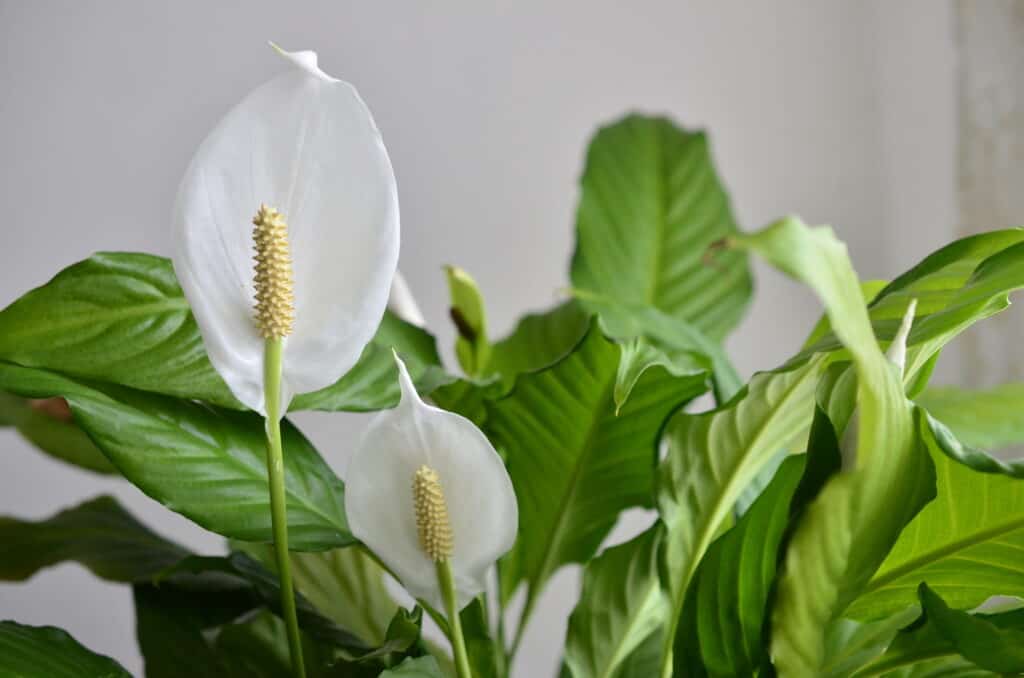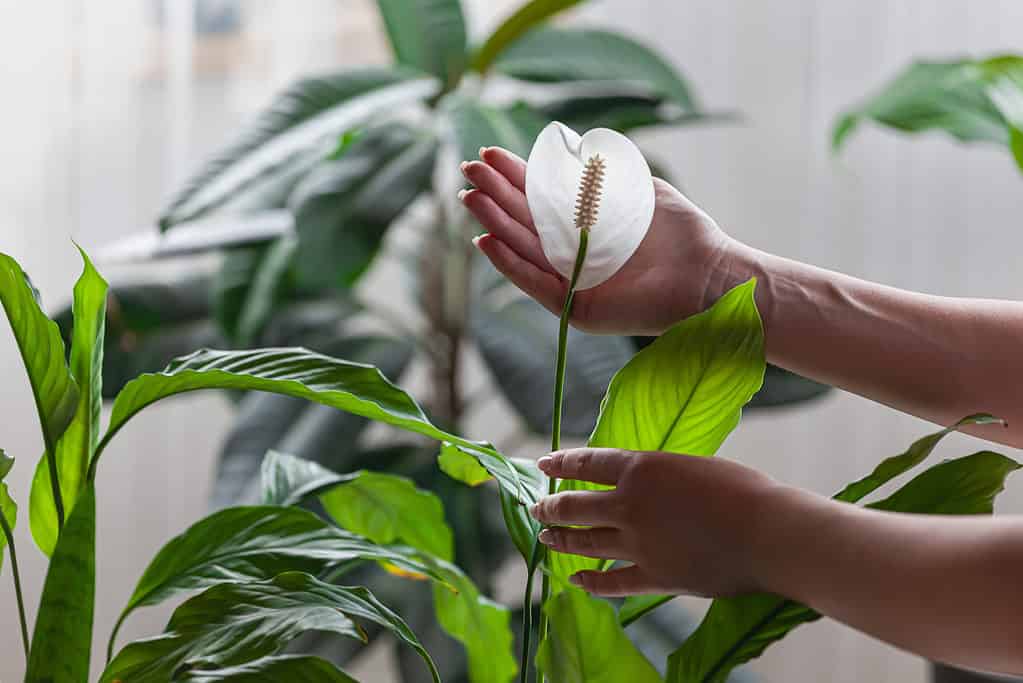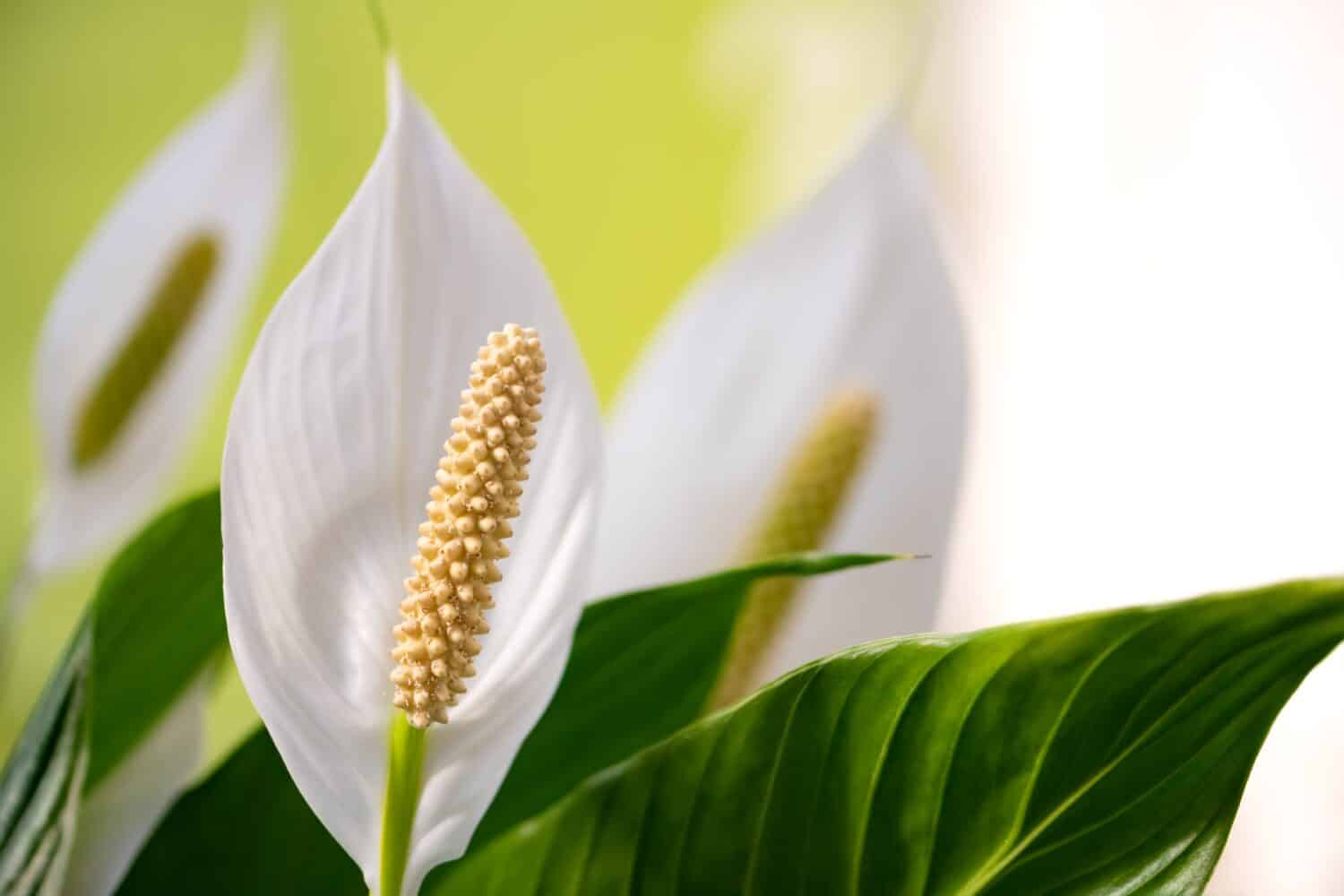The peace lily is one of the most exquisite plants to grow at home. It is indigenous to the tropics of the Americas and some parts of Asia. This stunning plant’s blossoms are unusual, and one-of-a-kind, and will look lovely in any garden. However, due to the fact that it is a tropical plant, it will need to be in conditions that replicate a tropical environment.
The peace lily is an evergreen plant with green leaves that are sometimes speckled with color or simply a deep green, making it a popular plant to keep for aesthetics. Contrary to popular belief, the peace lily is not restricted to indoor environments. However, you should be aware that the peace lily thrives in an outdoor setting only if the right conditions are met. You must make sure to supply the plant with an appropriate environment and a regular watering and fertilizing routine. The peace lily prefers some shade and does best in a warmer environment with the right amount of sunlight.

Peace lilies (pictured) can be kept outdoors in USDA hardiness zones 10 through 12.
©armifello/Shutterstock.com
The main factor for why so many people choose growing peace lilies inside is that they have superior environmental control within their homes. But if the plant is outside, that won’t be possible. The peace lily is a perennial flower that becomes as tall as six feet if left to its own devices. But, the size depends on the cultivar type. A few peace lily species may only grow as tall as 16 inches outside.
Interested in growing your peace lily outdoors? You must be certain that you are aware of the peace lily’s requirements if you choose to grow it outside. Your peace lily might not live if these conditions are not satisfied. In this in-depth guide, we’ll explore everything you need to know about growing this gorgeous tropical plant outdoors.
Can You Grow a Peace Lily Outside?
The answer to this question is “yes” but with some very important stipulations. In general, peace lilies can only be grown outside in USDA hardiness zones 10, 11, and 12. If your hardiness zone is too cold, it may not be possible to grow your peace lilies outside directly in the soil. However, if you’re comfortable with growing your plant outside in a pot, you can bring them inside during the winter to avoid unfavorable temperatures.
Are Peace Lilies Considered Invasive?
When considering planting your peace lily outside, you might be concerned about potentially introducing an invasive species into the outdoor environment. Luckily, peace lilies are not generally invasive plants. This is due to the fact that peace lilies grow from their roots. Instead of starting from the mother plant’s stem, new growth develops from the roots up. The new growth subsequently develops independent roots, enabling separation from the parent plant and subsequent relocation. However, the only practical way to do this is by deliberate propagation. So, you won’t have to worry about your peace lilies taking over your yard or your neighbor’s yard. If you are worried about your peace lily taking over your outdoor space, regular pruning can keep them down in size.

Outdoor peace lilies (pictured) can really thrive outdoors with the right conditions.
©iStock.com/Olga Chuprina
How to Plant a Peace Lily Outside
The peace lily is an evergreen perennial with simple, thin, bright green leaves that can grow up to one foot long. It forms a thick cluster. The plant’s actual flowers are small and cover a stalk called a spadix. The spadix is encircled by a single leaf, or spathe, that is creamy-white and held on a long stem. Numerous species of peace lilies exist and numerous varieties of peace lilies have been created by hybridization, including cultivars that may grow in clumps up to five feet wide and as tall as six feet. And with the right conditions and care, you can ensure your peace lily thrives when planted outdoors.
Sun Exposure
The peace lily is unable to tolerate prolonged sun exposure. The plant requires protection from direct sunshine and does best in some shade. As much as possible, you should maintain the plant in dappled shade since it thrives there. As a tropical plant, the peace lily is used to growing under the canopy of tropical rainforests. If you cannot find a spot under a tree to plant your peace lily, consider creating an artificial canopy for it or planting it near the roof overhang of your home.
The plant may burn out and develop sunburns as a result of prolonged exposure to the sun, which may eventually restrict the plant’s development. In severe cases, if this is not corrected, it can even entirely harm a young plant. This plant cannot be exposed to the afternoon sun, and it can tolerate the early sun for approximately an hour. The scorching heat of the afternoon sun can seriously harm your plant.
For the peace lily, sunburn is a very significant issue, especially when it is planted outside. For this plant, the sweltering afternoon hours are simply awful. Therefore, if your peace lily is placed outside without any shade, it will definitely perish, especially if your area receives a lot of sunshine.
You might want to think about growing your plant indoors if it won’t get enough shade outside. It all depends on how much sun your garden receives and where the plant is located. If you’re willing to construct a canopy for this plant, its chances of surviving outdoors are much better.

Fertilizer is essential for a peace lily’s growth.
©VH-studio/Shutterstock.com
Soil and Fertilizer
Healthy, rich, and well-draining soil is what the peace lily prefers. The plant will have significant issues if the soil does not drain effectively, as waterlogging can easily kill its roots.
Making sure to include compost when planting the peace lily is one of the best things you can do for the plant. If you don’t compost at home, consider buying plant fertilizer. It is essential to fertilize the plant sometimes, especially when initially planting it outside. To help the peace lily develop correctly on its own, you may apply mulch around the plant as well to protect the soil from the elements. Overall, the peace lily is a low-maintenance plant that requires just a little amount of fertilizer throughout the course of its lifetime, whether grown indoors or outdoors.
If you want to keep the plant in top shape as the summer months draw closer, you may think about employing a 10-10-10 combination fertilizer. This contains 10% each of nitrogen, potassium, and phosphorus. This plant normally needs a 20-20-20 formula when grown inside, although outdoor plants perform better with a 10-10-10 mix.
It’s worth noting that because fertilizer can be beneficial for establishing this plant outdoors, you should opt to initially plant your outdoor peace lily around the end of spring. That way, you can prep your outdoor soil with fertilizer and then directly plant your peace lily, giving it a better chance of survival.
Watering Your Peace Lily
The peace lily plant tends to lose a significant quantity of moisture over time because of its large leaves. Make sure the plant receives enough water by checking the flow of water in the soil. When cultivated outside, it will gradually lose even more moisture, thus it is important to have a good watering routine in place. Set up a watering schedule. Although you won’t really need to worry about overwatering it because it’s a tropical plant (though overwatering can definitely happen), it always pays to check the soil first before adding extra water.
Careful watering practices are necessary since excessive moisture will result in root rot and will introduce a plethora of fungal illnesses to the plant. You should water your peace lily a little less frequently in the winter since it will be able to store more water when the temperature decreases. The best approach to determine whether your plant needs water is to examine the soil with your finger by poking it to detect dryness. Simply give the plant additional water if the soil is dry.

The peace lily (pictured) may need to be kept outside in a pot so that it can be brought indoors during frosts.
©iStock.com/perfectlab
It is advised that you wait a day or two before watering again if the soil feels damp to you. Ideally, you should water the plant several times a week throughout the summer, and this is normally a good idea to keep the plant healthy. Indoor peace lilies can be watered once per week, but outdoor peace lilies need a bit more TLC.
This plant is quite sensitive to cold water as well as chlorinated water, so you should avoid using either of those. Use filtered water that has been warmed or brought to room temperature. To make this procedure simpler, you may purchase products that remove chlorine from the water that your plants use, such as a fishtank tap water conditioner.
Can Peace Lilies Tolerate Frost?
Temperatures below 45 degrees F and chilly drafts are not favorable for peace lilies. It is better to display them away from any heating or cooling equipment and keep them indoors for most of the year. But if you choose to plant them directly in the soil outside, keep in mind that covering them up during a frost may not be enough. In general, your hardiness zone should be one that does not have very regular frosts.

Diatomaceous Earth really kills bugs, yet it won’t stop them immediately.
©FotoHelin/Shutterstock.com
Are Peace Lilies Susceptible to Pests?
Unfortunately, peace lilies are indeed susceptible to outdoor pests. There is a sizable chance that the peace lily may be exposed to illnesses and pests because it will be planted outside. If you don’t pay attention to the signs of infestation, it won’t be long before the plant is attacked by common insects and pests like scales or mealybugs. Aphids can harm the plant as well if they are allowed to proliferate unchecked.
In order to spot symptoms of an infestation, you must periodically use a pesticide on your peace lily and keep a close eye on it. Eco-friendly products like neem oil, diatomaceous earth, and organic dish soap can be utilized if you don’t want to use a chemical pesticide.
A mealybug infestation can spread very fast if you have one. A major infestation is indicated by the development of a white residue on the plants. Thankfully, controlling these pests isn’t a significant issue. All you need to do is apply your pesticide of choice and spray it on the plant regularly for a few weeks. The peace lily will occasionally need to be pruned as well.
Are Peace Lilies Toxic?
The calcium oxalate crystals found in peace lily plants can irritate the mouth and throat and make people and animals queasy if any portion of the plant is consumed. It is preferable to maintain outdoor peace lilies in a fenced-off area away from young children, pets, and children. If you don’t have pets or children, you can plant your peace lily wherever you’d like outside. Simply touching them won’t cause irritation; they are only dangerous if eaten.
You may enjoy lovely peace lily plants in your yard for many years to come with the proper location and maintenance. Just keep in mind that this is an ongoing process, and you’ll need to maintain your plant regularly for it to survive outside.
Want to learn even more about this amazing plant? Check out our complete guide to peace lilies here.
Bonus: Why are Peace Lilies Given at Funerals?

Peace Lilies are frequently given to someone who is in mourning.
Image: ON-Photography Germany, Shutterstock
©ON-Photography Germany/Shutterstock.com
Peace lilies are often given to someone who is in mourning and, along with other varieties of lilies – are often used to decorate at funerals or visitations. It is considered to be a go-to funeral flower because of the significant meaning behind its blossoms. Lilies represent the soul’s return to a peaceful state of innocence. The peace lily plant symbolizes innocence and the rebirth of the departed’s soul from the physical world to a greater place. Potted peace lilies are an appropriate gift for a friend in mourning because they can carry the plant home to brighten their lives for a long time to come.
The photo featured at the top of this post is © iStock.com/dmf87
Sources
- NCSU Staff, Available here: https://plants.ces.ncsu.edu/plants/spathiphyllum/
- Daniel Iseli, Available here: https://plantophiles.com/plant-care/peace-lily/
- Daniel Iseli, Available here: https://plantophiles.com/plant-care/can-peace-lily-survive-outdoors/
FAQs (Frequently Asked Questions)
Where can I grow peace lilies outdoors?
Peace lilies can be grown outdoors in USDA hardiness zones 10 through 12.
What conditions do outdoor peace lilies need?
Peace lilies need plenty of shade and ambient light. They also require slightly moist soil.
How long can a peace lily stay outside?
Peace lilies can grow outside throughout the year, but must be brought in when temperatures dip below 55 degrees F.
Thank you for reading! Have some feedback for us? Contact the AZ Animals editorial team.






